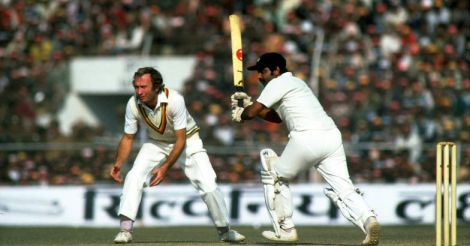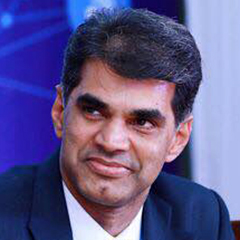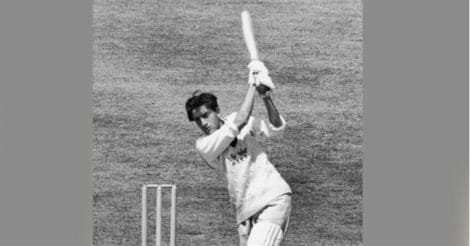If history of Indian cricket till date is written, 1974 would undoubtedly rank as the worst year. Indian team toured England in 1974 with great hopes of retaining the 'rubber' by repeating their performances of 1971, but ended up with a drubbing that cricket fans would never forget. Soon after the side landed, it became evident that it was not capable of even holding the hosts to a draw, let alone defeat them. The team was plagued by poor selection, dissensions within the squad, poor form of senior players and injuries to key members. Skipper Ajit Wadekar was unable to provide the necessary leadership and could only watch helplessly as the side lurched from one crisis to another, on and off the field.
India lost the first Test by 113 runs, with the match ending in the 13th mandatory over, indicating that with some more effort, the team could have managed a draw. In the second Test at Lord’s, India allowed England to pile up 629 runs and folded up for a paltry 42 in the second innings, while following on. After that the side just went through the motions during the last Test, which they lost by an innings and 78 runs, with the match getting over in just three days.
Angry fans
It would be an understatement to say that fans in India reacted angrily to the debacle. Effigies of players were burnt, a “victory bat” erected at Indore to commemorate the victories in 1971 was defaced and there were reports that stones were hurled at Wadekar’s home. The team returned home in disgrace in ones and twos. When the domestic cricket season started, Wadekar found that he had been dropped from the West Zone side. Feeling humiliated, he announced his retirement from the game.
There was near unanimity among all sections - players, press and public - that Mansur Ali Khan Pataudi, who had been removed as captain in 1971 should be recalled to lead the side against the West Indies, who were slated to tour India during the 1974-75 season. This was a new look West Indies team led by Clive Lloyd who replaced Rohan Kanhai at the helm. Present in the squad were senior players such as Roy Fredricks and Lance Gibbs, besides talented youngsters like Alvin Kallicharan, Lawrence Rowe and Andy Roberts, then the fastest bowler in the world, as well as promising newcomers Gordon Greenidge and Viv Richards. Selectors initially appointed Pataudi as the captain for the first two Tests, but the latter would have none of it and demanded that either he should be asked to lead in all Tests or should not be considered to lead at all. Selection committee judged the popular mood correctly and quickly announced his appointment as captain for the Test series.
India lost the first Test of the five-match series by a huge margin of 267 runs. Most of the Indian batsmen, barring Sunil Gavaskar and G R Viswanath, found Roberts too hot to handle. To make matters worse, Pataudi injured his finger while fielding and ruled himself out of the next Test. Gavaskar was appointed as captain, but he suffered a fracture in his hand while playing in a Ranji Trophy match against Maharashtra in the gap between the two Tests. On the eve of the match no one knew who would be leading the side. One of the office-bearers of the Delhi Cricket Association, which was hosting the Test, announced that Farokh Engineer would be the captain. But some more developments took place late in the evening and it was S Venkataraghavan who went out for toss with Lloyd the next day! Not surprisingly, India lost the Test by an innings and 17 runs with more than a day’s play remaining.
Memorable Test
Pataudi was back at the helm for the third Test at Calcutta, which was played from December 27, 1974, to January 1, 1975. Gavaskar was still on the injured list and Venkataraghavan was relegated to the role of being the twelfth man. India started poorly losing three wickets for 32 runs as Roberts generated top pace from a helpful surface. Pataudi, who walked in at No. 5, was struck on his chin by a bouncer from Roberts and had to retire for treatment. However, the Indian innings was salvaged by Viswanath and debutant Anshuman Gaekwad. Pataudi resumed his innings and contributed a stroke-filled 36, but it was obvious that he was not comfortable with the pace and bounce of Roberts. The Indian innings folded up for 233.
When the West Indies batted, Pataudi used the strategy of denying them singles and twos, thus forcing them to take risks and hit boundaries. The Indian spinners bowled a tight line, but the rewards were garnered by Madan Lal, bowling his medium-paced stuff! Except for Fredricks, who hit a century, none of the other West Indian batsmen could get going and they ended up with a first innings lead of mere seven runs. The Indian second innings was held together by a brilliant 139 by Viswanath, with the support of Engineer, who scored a polished half-century, and a defiant knock by debutant Karsan Ghavri. Thanks to their efforts, West Indies were set a target of 310.
West Indies commenced their second innings after lunch on the fourth day. Ghavri drew first blood by dismissing Greenidge cheaply while Bishen Bedi breached the defense of first innings centurion Fredricks. Richards joined Kallicharan and the duo began to dominate the Indian attack. Richards, in particular, was in superb touch and nothing that the Indian bowlers tried had any effect on him. B S Chandrasekhar, who had dismissed him cheaply in both innings at Bangalore, was having a poor day on the field and Richards pulled and cut him to the ropes repeatedly. As the total crossed 100, the worry lines on the faces of Indian fans grew deeper. At this juncture, in a move that surprised everyone, Pataudi brought on Madan Lal to see whether he could work up some magic on the rampaging Richards.
When a spinner is taken off the attack by an Indian skipper and replaced by a medium-pacer in the last innings of a Test in India, it invariably signals that he is running out of ideas. The sight of Madan Lal, who posed little threat on account of the pace he generated, lulled Richards into a sense of complacency. Madan Lal pitched one up and Richards, a trifle jaunty, played back, instead of going firmly forward. The ball sneaked through the small gap left between the bat and the pad and rattled the stumps! India had got the breakthrough that they needed so badly and the crowd heaved a huge sigh of relief. Lloyd joined Kallicharan and the duo took the score to 146 when stumps drawn for the day. There was no doubt in the minds of everyone following the match that had Richards remained at the crease the West Indies total would have reached in the vicinity of 180 to 200. Thus Pataudi had managed to take the match into the fifth day, and into 1975, by his unorthodox move of bringing Madan Lal into the attack when Richards was in full cry.
Chandra turns it around
When play resumed on the final day, there was a full house at Eden Gardens, with around 80,000 spectators praying fervently for an Indian victory. Pataudi started with Chandrasekhar from one end. This was most unusual as most captains preferred to start the proceedings with Bedi who being more accurate and consistent would not give away easy runs. Moreover Chandrasekhar had bowled poorly the previous day. Couple of bad overs from him in the beginning of the final day would swing the fortunes firmly in favor of the visitors. The crowd waited anxiously as Chandrasekhar marked his run up and started bowling. After a quiet first over, Lloyd suddenly cut loose in the second over off Chandrasekhar, hitting him for three boundaries in quick succession. What everyone feared had happened and the West Indies appeared to have snatched the upper hand solely on account of this unusual move by Pataudi. The crowd started getting restive and began to chant slogans demanding the removal of Chandrasekhar from the attack.
However, Pataudi was unfazed. He knew that Chandrasekhar alone possessed the capability for swinging the match India’s way by picking up quick wickets. It was certainly a gamble to continue with him after Lloyd had hit him for three boundaries in one over. Nevertheless, Pataudi signaled to Chandrasekhar to start the next over even as crowd was looking for a bowling change. Seeing Chandrasekhar walk to the top of his bowling mark to commence a fresh over, Eden Gardens let out a collective roar of disapproval.
It would have tested the guts of even the bravest of captains to ignore the deafening clamor consisting of catcalls and boos emanating from the 80,000 people in the stands and continue with Chandrasekhar. The situation would have worried the police and other agencies involved in law enforcement, given the history of riots that had rocked matches held at this venue in the past. Pataudi appeared to be oblivious of all the commotion taking place outside the playing arena and calmly readjusted the field for the bowler.
Chandrasekhar did not let down his skipper. He produced a peach of a delivery that beat Lloyd all ends up and uprooted the stumps. Indian fielders rushed to the bowler to congratulate him even as celebrations broke out in the stands. Soon after, Chandrasekhar found the outside edge of Kallicharan’s bat and the resultant catch was held by Viswanath at slip. Shortly thereafter, he trapped the dangerous Bernard Julien in front of the wicket, reducing West Indies to 186 runs for the loss of six wickets. Thus, in a superb spell, Chandrasekhar broke the back of West Indies’ batting, justifying the faith that his skipper had placed on his shoulders.
His job done, Pataudi removed Chandrasekhar from the attack. Bedi continued from where his spin partner had left off and ran through the lower middle order and tail, to dismiss West Indies for 224, thus giving India a victory by a margin of 85 runs. The crowd sought to make amends for its boorish behavior in the morning by demanding that the winning captain and his side come out for a lap around the stadium. Pataudi was initially reluctant, but finally came out and acknowledged the cheers of the crowd.
 G R Viswanath. File photo
G R Viswanath. File photoThis victory restored some amount of confidence in the national side among the fans. The teams moved to Madras where the next Test was to take place. This Test has been immortalized in the history of Indian cricket for the magnificent unbeaten knock of 97 played by Viswanath in the first innings when Roberts was bowling at his fastest on pitch that offered pace and bounce. Electing to bat first after wining the toss, India found themselves reduced to 41 for four and then to 117 for eight as none of the batsmen, except Viswanath, possessed the technique and skill to tackle the thunderbolts unleashed by Roberts. Indian innings finally closed at 190 when Viswanath ran out of partners. In reply, the West Indies could manage only a nominal two-run lead as Prasanna hit top bowling form to pick five wickets. India performed better in the second innings to score 256 and then dismissed West Indies for 154 to post a 100-run victory. Thus, India drew level with West Indies at the close of the fourth Test.
Though the hosts lost the final Test at Bombay by 201 runs and with that the series, the Indian players came out with their heads held high. The strong comeback by the hosts after losing the first two Tests by big margins exhilarated the cricket-loving public, who had never seen the likes of such resurgence before. It was acknowledged by critics and cricket lovers alike that this sudden turnaround in the fortunes of the side was fashioned by none other than the skipper himself. Though he himself was not contributing much with the bat, he was in absolute control of the proceedings, on and off the field, and commanded respect from his teammates and adversaries alike.
The whole nation saluted Pataudi as he stepped off field at Bombay, as they knew that they would not see him again in the international arena. His decision to retire from Test cricket was not surprising as he found it distinctly disconcerting to tackle the extreme pace of Roberts. A proud player like him would not even think of hanging on to his place in the side and would rather go before he overstayed his welcome. But before stepping down, he had restored national pride by leading the side with panache and gave the strong West Indies side a run for its money. Praises were showered on him even by those who had been critical earlier about his style of captaincy. It appeared that God had decided to make amends for the earlier humiliations heaped on him by giving him a grand farewell, thus acknowledging the contributions he had made to the game and the nation.
(The author is a former international umpire and a senior bureaucrat)
Read more from Vantage Point | Father-son pairs in Indian cricket

























 Mansur Ali Khan Pataudi. File photo: Getty Images
Mansur Ali Khan Pataudi. File photo: Getty Images
